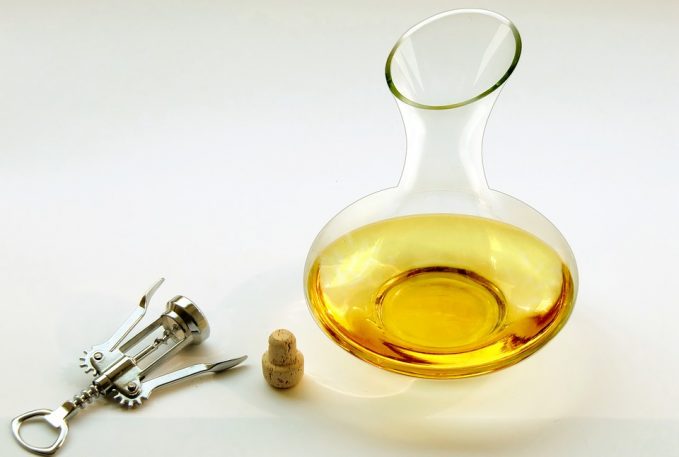
The ritual of decanting can be intimidating to those who have never partaken in such an event. With all the pomp and circumstance associated with it, you’d think you’d have to be a neurosurgeon to attempt it. Au contraire, mes amis. It’s really quite simple. First, cut back the foil cap. Make sure it’s cut far enough so the wine, when poured, does not make contact with it. If the tops of the bottle and cork need cleaning, gently wipe them with a damp cloth. Insert your cork screw and extract the cork very gently. You may want to wipe the top of the bottle again. If you’re decanting to remove sediment from wine, you’ll need a bright light source (candle or flashlight) and a container (decanter) in which to pour the wine. A decanter can be anything from a finely etched crystal container to a Flintstones jelly glass. (I personally prefer the Dino decanter!) If the sediment is at the bottom of the bottle, where preferably it should be, place the light under the bottle’s neck and, in one continuous movement, slowly pour the wine into the decanter. As the level of wine decreases in the bottle, carefully watch the neck. As soon as you see sediment nearing, stop pouring. Pretty simple. If cork has fallen into the wine, decanting is used to remove these unsightly foreign objects. Usually, not always, the cork will be the first out when poured. Take a small container aside, and carefully pour the wine (and cork) out. If the cork doesn’t want to come out, then careful decanting over a light source may be necessary. Why do you want a wine to breathe? Well, with some reds, and a few whites, affording the wine a little oxygen actually helps it show its true colors. Without getting technical, wine basically softens and smooths out through molecular polymerization. Meaning, if you have a red wine with a heavy tannin content (chewy/chalky finish), allowing it to oxygenate helps smooth the rough tannins out. Sometimes with both whites and reds, the wine just needs some oxygen to bring out its flavors. I equate wines with flowers. Like a young rose, wines have everything inside to make them beautiful. If allowed a bit of oxygen, it will blossom and open up, like the rose, to show its true beauty. But always, ALWAYS, taste the wine before deciding to let it breathe. It’s etched in some people’s minds that older wines NEED to be decanted. NOT! Sometimes a wine’s first breath is its last. If you’re decanting to simply let wine breathe, let it splash a bit as it’s poured into the decanter. Not too aggressively. Just enough so it splashes against the lower sides of the decanter. Then taste it again immediately. Just this little bit of oxidation can open the wine quite a bit. Pouring from large format bottles is always impressive. So if you’re celebrating with a salmanazar (9 liter) bottle, you may want to consider decanting the wine into smaller containers to make it easier to pour into wine glasses. Obviously, if the wine contains sediment, you’ll want to decant as mentioned above. If there is no sediment, simply pour the wine into smaller containers as needed. This method can also be used with regular size bottles at large functions, where the wine needs to be two places at once. |




